Section 5.4. Models of Trust
5.4. Models of TrustResearchers have developed a variety of models of trust components, antecedents, and/or consequences.[42] The advantage of models is that they may make fuzzy concepts clearer by defining terms and concepts. They can also provide structure where none existed before. More practically, developing a model may lead to specific metrics of interest that can be measured in research studies using questionnaires or other instruments. Models of trust can also lead to specific development advice. Some researchers working in the trust area, such as Egger, have used their models to develop criteria or checklists that practitioners can use to evaluate and improve a web site or similar service. In this section, we review some of the models of trust, pointing out the similarities and differences, and we conclude with some specific lessons that the models can provide for developers.
5.4.1. Early Work on Modeling TrustSome of the earliest work on modeling trust focused on different components of the concept. Mayer et al.[43] proposed that trust is based on a set of beliefs about trustworthiness , and that the most important beliefs concerned ability, integrity, and benevolence:
Gefen[44] operationalized this model of trust components by developing a questionnaire that addressed the three concepts of ability, integrity, and benevolence. Students who used the Amazon.com web site were asked questions related to Amazon's ability (e.g., "Amazon.com knows about books"), integrity (e.g., "I expect that Amazon.com will keep promises they make"), and benevolence (e.g., "I expect that Amazon.com has good intentions toward me"). Analysis of the results showed that these concepts are reliable, statistically independent, and valid for predicting past shopping behavior and future intentions.
5.4.2. Bhattacherjee's Model of TrustBhattacherjee took a different approach and focused on the antecedents and consequences of trust for e-commerce situations.[45] That model consists of three components and, like many others, Bhattacherjee uses a flow diagram to illustrate the proposed relationship between the components, illustrated in Figure 5-1. The component of familiarity is defined as knowledge of the trustee based on prior interactions or experiences. Trust is assumed to be made up of beliefs in ability, benevolence, and integrity, based again on the pioneering work of Mayer et al. In this model, familiarity can lead to trust, which in turn can lead to a willingness to transact. In addition, familiarity can lead to a willingness to transact directly, even without feelings of trust. Such a situation might occur if a customer continues to transact with a vendor out of habit or convenience, even though there may be a lack of trust. Like Gefen, Bhattacherjee developed questionnaire items to operationalize each of the components in the model, and then demonstrated in an empirical study that the concepts were related in the expected statistical manner.
Figure 5-1. Bhattacherjee's model of trust 5.4.3. Lee, Kim, and Moon's Model of TrustA similar model of trust for e-commerce was developed by Lee, Kim, and Moon.[46] The model, illustrated in Figure 5-2, also describes antecedents to trust, this time focusing on three concepts: comprehensive information, shared values, and communication. In a way, these antecedents are describing the things that might be learned in the familiarity component proposed by Bhattacherjee, so the two models are similar in that respect. What makes the Lee et al. model unique is the addition of a transaction cost component that is seen as being in opposition to trust. In this model, trust and cost are combined, in opposite directions, when customers make their decisions about e-commerce behaviors (in this case, customer loyalty). Lee, Kim, and Moon describe three antecedents to transaction cost: uncertainty, the number of competitors, and specificity (the nature of the store or transaction).
This model is important because it describes both trust and cost as being independent, opposing factors. According to the model, customers will choose to continue a relationship with a vendor if factors leading to trust are strong and factors leading to transaction costs are weak. We have recently adapted the model to replace transaction costs with the more general concept of perceived risk, and found it to be useful for explaining trust in a different domain.[47]
5.4.4. Corritore's Model of TrustCorritore et al. also included trust and risk in their model (see Figure 5-3), although they proposed that increased perceptions of risk lead to decreased trust, instead of having trust and risk be independent factors.[48] This model also includes perceptions of credibility as a concept related to risk, and as we have seen, assessments of credibility are seen to be related to perceptions of honesty, expertise, predictability, and reputation. Corritore et al. also include ease of use in their model, and this is meant to measure how easy it is for a truster to achieve his goals (e.g., find the desired goods or complete the transaction). They propose that ease of
Figure 5-2. Lee, Kim, and Moon's model of trust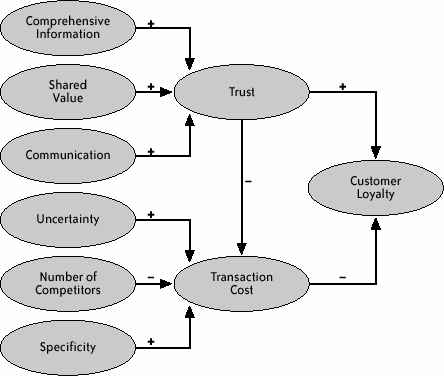 use affects both credibility and perceptions of risk. Finally, this model also includes external factors that might affect a trust judgment. Such external factors include the environment or context of the transaction, the characteristics of the truster (e.g., a risk-seeking or risk-averse personality), the characteristics of the trustee (e.g., web site design), and the overall risk related to the transaction (e.g., the amount of money involved). Figure 5-3. Corritore et al.'s model of trust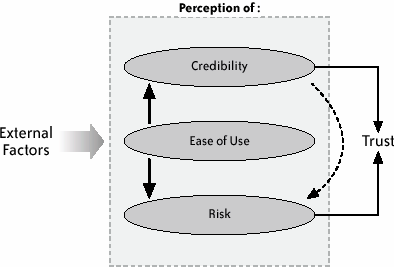 5.4.5. Egger's Model of TrustIn another model of trust in e-commerce situations, Egger also proposed an important role for external factors.[49] In Egger's MoTEC model (see Figure 5-4), pre-interactional filters are included to describe those factors in place before any transaction takes place. Included in this concept are factors such as the truster's disposition to trust, prior knowledge or experience, information and attitudes transferred from others (friends, the media, etc.), the reputation of the industry and company involved, and trust in information technologies and the Internet in general.
Figure 5-4. Egger's MoTEC model of trust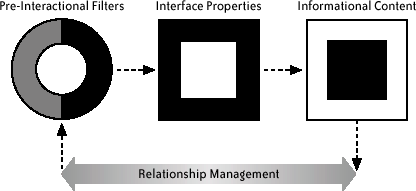 Two other important concepts in Egger's model are special roles for interface properties and informational content. Egger argues that interface properties, such as the visual appearance caused by graphic and visual designs, are important for creating first impressions that affect trust. Egger describes how trusters new to a situation or transaction make rapid assessments based on superficial cues about the usability, navigation, and reliability of an e-commerce application or web site. Later, the trusters may pay attention to the informational content in a slower, secondary phase of trust judgments. Here, trusters assess competence and risk as they learn more about the transaction. Finally, MoTEC includes a relationship management component to explain the trust that may build up over time. Here, trusters assess the responsiveness and helpfulness of a vendor, and how well transactions are completed over time, including fulfillment and after-sales support. In this way, Egger proposes a three-stage model of trust:
5.4.6. McKnight's Model of TrustTaking into account the different models of trust described so far, each one proposing both common and distinct features or components, it is not surprising that there have been some attempts to build larger, more comprehensive models of trust. For example, McKnight and his colleagues[50] have developed a relatively complex model that includes many of the components proposed before (see Figure 5-5). This model outlines antecedent factors to trust in an e-commerce situation. Included are the factors of disposition to trust and trust in technology and the Internet (institution-based trust), as we have seen before. The model also includes the various attributes of a trustee, such as competence, integrity, and benevolence, which can contribute to trusting beliefs. One unique feature of the McKnight model is the distinction between trusting intentions and trusting behaviors. This is an important distinction because, although the theory of planned behavior[51] states that actions follow intentions, research shows that this is not always the case. It is one thing to state that you intend to do something (trust a vendor), but it may be quite another to actually do it. Very little trust research has actually measured true trusting behaviors, such as having trusters spend their own money in e-commerce transactions.
Figure 5-5. McKnight et al.'s proposed web-trust model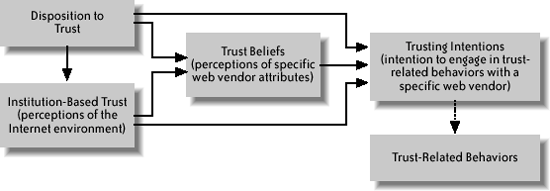 McKnight and his colleagues have also made their concepts concrete by operationalizing them. Specific question topics for each concept are shown in Table 5-1, and questionnaires have been developed to ask trusters about each of these areas. As others have done, McKnight et al. have tested these questionnaires and shown that the concepts hold the statistic relationships that were predicted.
5.4.7. Riegelsberger's Model of TrustAnother attempt at a comprehensive model has recently been described by Riegelsberger et al.[52] This model is somewhat different in that it focuses on the incentives for trustworthy behavior rather than on opinions and beliefs about trust or perceptions of trustworthiness. This model (see Figure 5-6) describes the trust situation for both the truster and the trustee. Both the truster and the trustee can choose to interact by performing trusting actions (truster) and fulfilling promises (trustee), or they can withdraw or not fulfill. Riegelsberger et al. describe what factors play a role in the decisions to take trusting actions and fulfill promises.
The first step in the model is for the actors to communicate by sending signals about a desire to interact. Often the situation is complex because the actors are separated in space (e.g., e-commerce buyers and sellers) and the actions are separated in time (e.g., delivery delays for e-commerce goods). Thus, signals can be important for showing trust-warranting properties. Signals are a method to demonstrate important intrinsic properties, such as benevolence, and they allow the actors to infer motivations and abilities. Riegelsberger et al. also include contextual factors in their model (see Figure 5-7), including temporal, social, and institutional properties. Social properties include things like reputation, while the institutional context is meant to convey things like the assurance given by job roles (e.g., bank tellers), regulations, and threats of punishment. This is similar to the situation normality concept included in the McKnight model. Riegelsberger et al. also describe different stages of trust that develop over time, and they discuss early, medium, and mature forms of trust. These concepts are not included in their model diagrams, however. Figure 5-6. Riegelsberger et al.'s proposed trust situation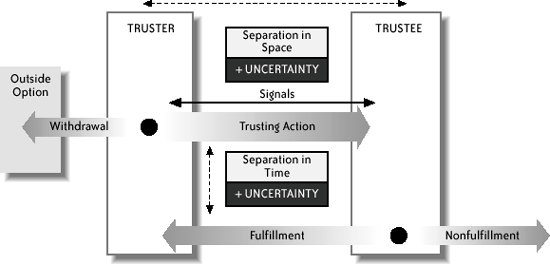 Figure 5-7. Riegelsberger et al.'s proposed trust-warranting properties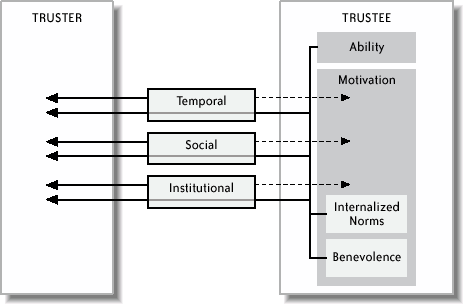 5.4.8. Looking at the ModelsWhat are we to make of all these models? Although they may all seem quite different, there are some common themes among them. More importantly, the research on the models can lead to specific advice to developers who want to build a trusted service:
| |||||||||||||||||||||||||
EAN: 2147483647
Pages: 295